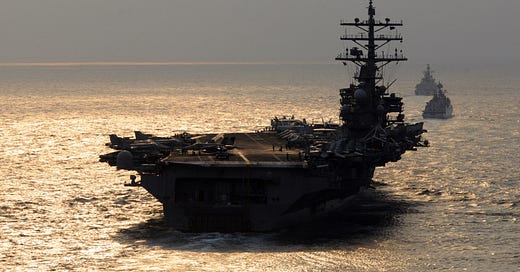We hope you enjoy this special edition of Contention! It’ll take eight minutes to read, and could spiral out of control. Let us know what you think. Share it with others who might like it too.
Last October, the Pentagon’s war planners simulated the U.S. military fighting a battle for Taiwan. The wargame is still classified, but the fictional foe was clearly China. The result: the U.S. forces lost -- and lost badly.
“Without overstating the issue, it failed miserably,” Gen. John Hyten, the vice chairman of the Joint Chiefs of Staff, said last month at the Emerging Technologies Institute, a think tank sponsored by the National Defense Industrial Association (NDIA). “An aggressive red team that had been studying the United States for the last 20 years just ran rings around us. They knew exactly what we're going to do before we did it.”
The NDIA, a military-industrial trade association representing hundreds of companies, would have heard that loud and clear, because it’ll be their job to design the technologies needed to -- possibly -- give the U.S. military a fighting chance in a future war in the Western Pacific. And that means hundreds of millions of dollars in new programs to replace the ones that have already become obsolete.
One of the U.S. military’s major vulnerabilities, according to Hyten: excessive faith in an “information-dominance structure,” the sensors and communications technologies that allow the military to “see” their adversary and make decisions faster. “Well, what happens if right from the beginning that information is not available?” Hyten asked.
Reading between the lines, the Pentagon thinks the Chinese People’s Liberation Army (PLA) can jam U.S. systems and shut them down.
That’s where the defense contractors are supposed to come in and fix the problem. In July, the Pentagon awarded up to $26.6 billion in contracts to 29 companies for the “Joint All Domain Command and Control Initiative,” or JADC2. The project would connect sensors from all branches of the U.S. military into a single network. Lockheed Martin, Northrop Grumman and Boeing have all presented their own white papers about using A.I. and machine learning to sort through the massive amounts of data such a system will generate.
The Pentagon also wants to send spaceships into suborbital altitudes to deliver 100-ton cargo payloads anywhere on earth -- like Taiwan if the PLA were to cut it off. That’s roughly the same cargo a C-17 transport plane can carry, but could be shot down before it gets anywhere close to China.
In June, the Pentagon also explained who they want to do that job: private companies like SpaceX which are testing reusable rockets at its facility in Texas.
“Today we are going to build the interfaces and the inroads to encourage more and more companies to enter into that realm,” Greg Spajers of the Air Force Research Laboratory said at a news conference. “Hopefully they perceive a return on investment, in a business case that’s approved by the [Pentagon] expressing interest in buying the service down the road.”
The Air Force’s proposed 2022 budget has requested $50 million for more research and development in spacefaring “rocket cargo.” This follows smaller programs underway now with SpaceX and Texas-based Exploration Architecture Corporation.
One larger problem for the U.S. military: many of its weapons -- which it spent billions of dollars developing -- are not cut out for this imagined future war. In recent months, the U.S. Navy began quietly scrapping some of its $500-million-apiece littoral combat ships -- designed back in the 1990s to fight in shallow waters, but more or less useless versus China. These expensive boats have also suffered from structural flaws and engine breakdowns.
Then there’s Lockheed’s notorious F-35 Lightning II -- the most expensive weapons project in history at more than $1.7 trillion over its lifetime. The fighter jet has so many flaws that former Defense Secretary Patrick Shanahan described the program that developed it as simply “fucked up.”
Some U.S. Air Force generals don’t even want to include the fighter in simulations of a war with China in its current configuration. “It wouldn’t be worth it," Lt. Gen. S. Clinton Hinote said in April. “Every fighter that rolls off the line today is a fighter that we wouldn’t even bother putting into these scenarios.” He added that unless the U.S. military changes course “we’re going to lose fast” and be presented with a “fait accompli.”
None of this represents a failure on the part of the U.S. military. In fact, it’s a tremendous success. For the senior military officers who become executives and board members for the arms makers, the members of Congress they bankroll, and their privately-funded think tanks which define the problems -- and the solutions -- for the U.S. military the system has kept them extremely well-heeled.
Business drives policy and strategy, not the other way around. In China, on the other hand, arms companies are owned by the state, which some U.S. analysts admit is a more efficient system.
“We used to reject the Chinese numbers and think they couldn’t possibly be real, because how could China be making all this -- coming out with all these ships and aircraft on a budget where they’re only spending something on the order of 1.3% maybe 1.5% [of GDP]?” Lyle Goldstein of the U.S. Naval War College told The Grayzone back in March. “But if you look closely, we have come to the conclusion that their numbers are real.”
The ultimate test won’t be a game. It will be the tragic consequence of the United States refusing to mind its own business. Whether the companies that profited from the catastrophe are held accountable will be just one of many questions the conflict will be forced to answer.
Disclaimer
Our only investment advice: This business will get out of control.
Contact us with questions, concerns, feedback, or stories we might have missed.




